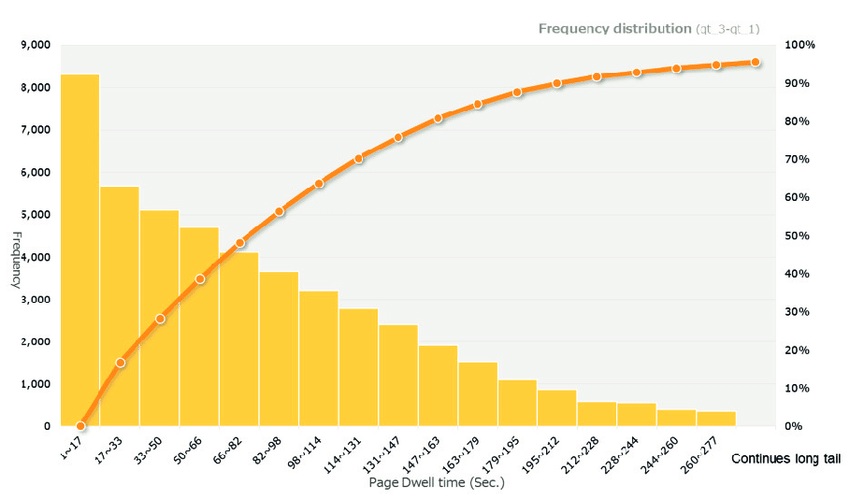Search engines, such as Google, use dwell time as one of many factors to determine the relevance and quality of a webpage. In this article, we cover everything you need to know about dwell time and also include some tips on how to use dwell time to boost your SEO efforts.
Understanding Dwell Time
Definition of Dwell Time
A broad definition of dwell time is that it refers to the amount of time a user spends (or dwells) on a website after clicking a link. To be specific, dwell time refers to the length of time that a user spends on a specific webpage found via search results before clicking back to the search engine results page (SERP).
Dwell time can be a useful metric as it can provide insights into how engaging their content is, how well their site is meeting the needs of their visitors, and how effective their search engine optimization (SEO) efforts are.
A longer dwell time is usually a good indication that visitors are finding the site useful and engaging. Conversely, a shorter dwell time may indicate that they aren't finding what they are looking for or that the content isn’t engaging enough to keep them on the page.

How to Calculate It?
There is actually no official formula for dwell time.
Most often, calculating dwell time is done by subtracting the time a user clicks away from a webpage from the time they click on the webpage. Here is how you can calculate it:
-
Choose the webpage you want to analyze and select a specific time, such as a day or a week.
-
Identify the starting time of each user session on that webpage.
-
Record when the user exits the webpage by clicking a link or closing the browser.
-
Calculate the dwell time by subtracting the starting time from the exit time for each user session.
-
Add the total dwell times and divide by the total number of sessions to get the average dwell time.
For example, let's say that a user clicks on a webpage at 3:00 PM and exits the page by clicking on a link at 3:25 PM. The dwell time for this session would be 25 minutes. Repeat this process for all user sessions and calculate the average dwell time by adding the dwell times together and dividing by the total number of sessions.
Generally, it is advisable to avoid dwell times of 30 seconds or less, while a dwell time exceeding two minutes is considered good. The average dwell time is commonly regarded as falling within this range.
How Does It Affect SEO?
While dwell time is not the sole determinant of search rankings, it is part of a broader set of user experience metrics that search engines use to evaluate the quality and relevance of a website's content.
Here's how dwell time affects SEO:
User Engagement Signals
Search engines aim to deliver the best possible results to users. If users spend more time on a particular page after clicking on a search result, it suggests that the content is relevant and valuable. This positive engagement signal can influence search engines to rank that page higher.
Bounce Rate Counterbalance
Dwell time is inversely related to bounce rate. Bounce rate measures the percentage of visitors who navigate away from a site after viewing only one page. If visitors quickly leave a page without engaging with the content, it can negatively impact bounce rate.
A longer dwell time indicates that visitors are spending more time on the site, reducing the bounce rate, which is generally seen as positive by search engines.
Content Relevance and Quality
Higher dwell time often correlates with content that is engaging, informative, and relevant to the user's query. Search engines aim to provide users with the best possible answer to their search queries, so if a page keeps users engaged, it is likely to be considered more valuable and could rank higher in search results.
Pogo-Sticking Consideration
Pogo-sticking refers to users clicking on a search result, quickly returning to the search results page, and clicking on another result. This behavior suggests that the initial result didn't meet the user's needs. Search engines may interpret prolonged dwell times as an indication that the user found what they were looking for, reducing the likelihood of pogo-sticking.
How to Increase Dwell Time
By boosting users' dwell time on your website, you can potentially improve engagement and lead to better SEO rankings. Here’s how you can start going about it:

Create High-Quality Content
To increase dwell time on your website, it's crucial to start with the foundation of high-quality content. Provide valuable and relevant information that aligns with the user's intent, ensuring that your content is well-written, informative, and easily comprehensible.
Additionally, incorporate engaging visuals such as images, videos, and infographics to enhance the visual appeal of your content and make it more captivating for visitors.
Improving readability is another key aspect. Use clear headings, subheadings, and bullet points to facilitate easy scanning, and break down large paragraphs into smaller, more manageable chunks.
Enhance User Experience
Enhancing user experience (UX) is a multifaceted approach that plays a pivotal role in increasing dwell time on your website. A positive UX not only encourages visitors to stay longer but also fosters a sense of satisfaction, potentially turning first-time users into loyal followers.
Here are some key aspects to focus on when aiming to enhance user experience:
-
Intuitive navigation
-
Responsive design
-
Fast load speed
-
Clear calls-to-action (CTAs)
-
Consistent branding
You can learn more about a good user experience in this blog.
Personalize Content
Lastly, consider personalizing content based on user preferences or behavior. Utilizing data to tailor content to individual users can enhance relevance, making it more likely that visitors will engage with your content for an extended period.
By incorporating these strategies, you can create an environment that encourages visitors to spend more time on your site, ultimately improving dwell time and positively impacting your website's performance in search engine rankings.
Final Thoughts
Now that you have a better understanding of dwell time, you can start using it to measure how engaged users are with the quality of the content on your website. It is, however, only one of many factors used by search engines for determining search engine ranking, and it should not be the main focus of your SEO efforts.
Concentrate on producing high-quality, relevant content, streamlining your site's layout and navigation, enhancing the user experience, and giving value to your audience to boost dwell time.














